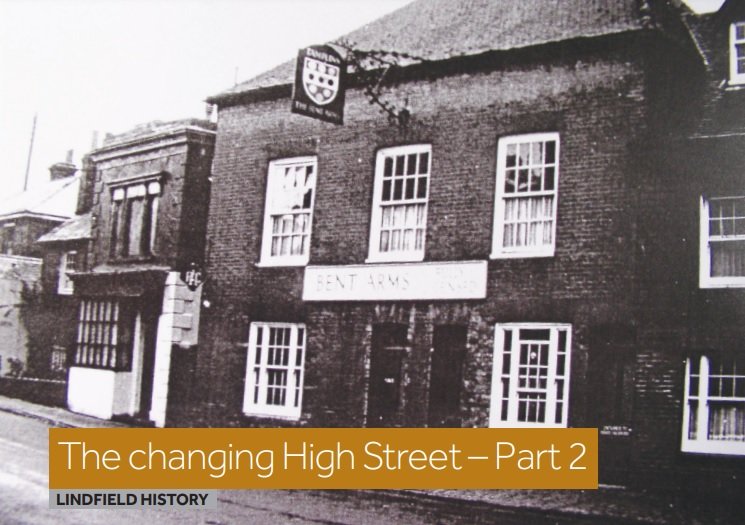The Bent Arms & The Cot
By John Mills and Richard Bryant, Lindfield History Project Group
The previous article compared the west side of the High Street in 1923 with 2023; in this article we journey down the eastern side. Starting at the top of the High Street, from the ornate Lindfield sign down to All Saints Church is residential today, as it was in 1923. After the church, the Tiger had ceased being an Inn in 1916, becoming the parish church house and has continued to be ever since.
After the passageway, 1 Tiger Cottages – No 120 – was a sweet shop called The Little Shop. Evidence of this past use can be seen in the remains of a shop front. After these cottages, Tallow Cottage, built in 1975, is the newest house in the High Street. It stands on the site of a wide entrance to the backyard and slaughterhouse of Wickham’s butcher’s shop and family home, which was situated in Oakley House (No 112). From this point down to the corner of Brushes Lane today is all residential - the exception in 1923 being Spongs, on the corner, which was Alfred Carey’s house and had his ironmonger’s shop attached. The large shop window is still evident, as is the old forge to the rear.
Brushes Lane was little more than a bridleway until 1957, when it was widened to provide access to the Dukes Road development. This necessitated the demolition of a building known as The Cot (see photo above) that had been built in the 1860s adjacent to the Bent Arms. Over the years it had had many uses, from railway company offices to storage to a dwelling and even, it is said, the Musical and Literacy Institute. To the rear of the Bent Arms is 96 High Street.
Previously the coach house and stables of the inn, it is now in mixed use. Today, from this point down to Boarsland on the corner of Alma Road is all residential. This was not the case a hundred years ago. Priory Cottage, No 86 - which was originally a medieval hall house - Crosskeys, No 76, and Boarsland, No 72, all had shop extension build-outs in their front gardens out to the pavement. Priory Cottage was a stationers and newspaper shop run by Ernest Welfare. Crosskeys, 76 High Street, also dating from medieval times, was divided into two cottages with the southern part having the front extension, which was the fishmonger’s and poulterer’s shop of Jacob Driver. Boarsland was Thomas Charman’s baker’s shop with the bake house behind.
Crossing over Alma Road, South Down Cellars wine merchants was, in 1923, H P Martin’s corn and coal merchant. A short mid-Victorian terrace known as Albert Terrace follows, today containing Ounce, Jackson-Stops, Somers café and Mathilda Rose. Respectively these were Mrs Helen Hodson’s confectioners, Rice Brothers’ saddlery and harness makers, Herbert Caffyn’s tobacconist and confectioners and finally at 1 Albert Terrace, John Holman’s Cycle and Motor Cycle Depot; until December 1922 it had been a cycle and gramophone shop.
Below the Red Lion stands Porters, a residential property that was previously Dr Hay’s surgery and family home. The private housing continues down to the United Reformed Church, originally the Congregational Chapel.
The next area was devoted to the Box family businesses. They ran a nursery that stretched parallel with Lewes Road and up Luxford Road. Interestingly, one of only a few shops to have continued the same trade over the period is Paul’s greengrocer’s. This had been James Box’s greengrocer shop. Next door was their florists, today Mark Revill & Co. Again, continuing the same trade is Cottenham’s, which was the Box butcher’s shop. Behind was Box’s storage and preparation rooms, today occupied by Nova Medispa – which recently moved from beside the Co-op.
In competition with Lloyds Bank across the road, Barclays had a sub branch in the first cottage, No 38. The neighbouring cottage was the home of John Sharman, Assistant Clerk to the Parish Council. This was followed by the Post Office and its adjoining sorting room, later extended into the Post Office and now Truffles Bakery.
Crossing Lewes Road and after Pear Tree House and the King Edward Hall in 1923 (and until recent times) was the White Horse Inn, now converted into Tamasha Indian restaurant. Slake Coffee Shop is housed in the inn’s stables. The private house – No 18 – did not exist in 1923 as this was the site of Lindfield Motor Garage owned by Messrs Boggis & Franklin. At Nos 14 and 16, the front shop extension, which is today the home of the Lindfield Barbers, was, a hundred years ago, a fishmongers and fish and chip shop run by Hubert Ellis. In later years it became the Pond Shop. Beyond this point the High Street remains residential, with the last property on the east side being Pelham House.
The big question is how does the High Street today compare with 1923? The answer in a few words is very favourably, with both serving the needs, trends and their communities of the time. There were a few more shops a hundred years ago but several in the same trade and presumably in competition. Missing today are drapers and ironmongers, but this a national trend. That said, it is probably fair to say, today’s shops collectively have a far greater range of goods than their earlier counterparts. Lindfield is fortunate to have such a vibrant High Street and long may this continue.
Contact via https://lindfieldhistoryproject.group/ or 01444 482136.



